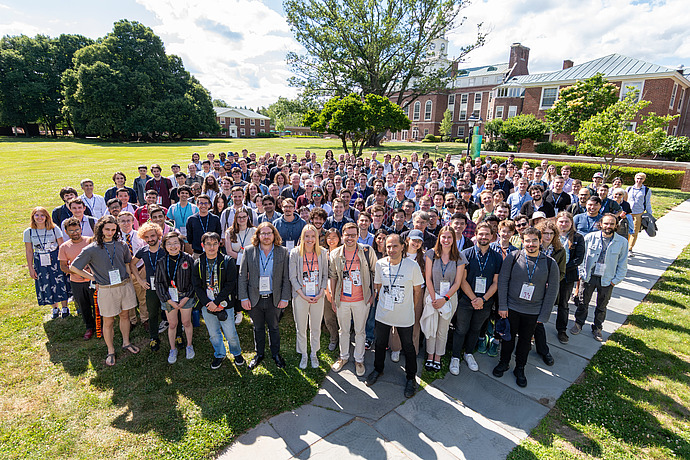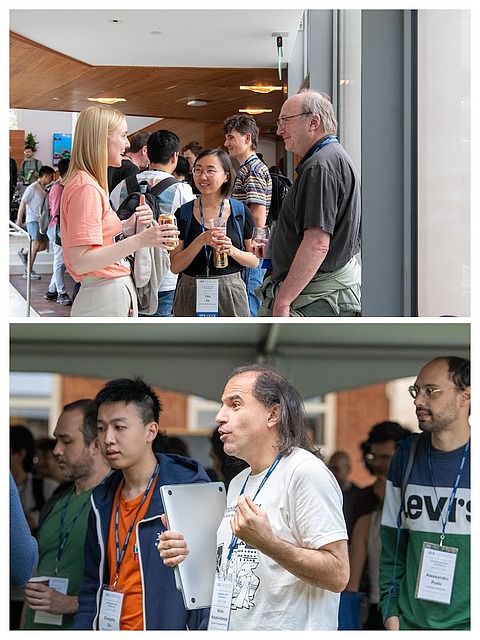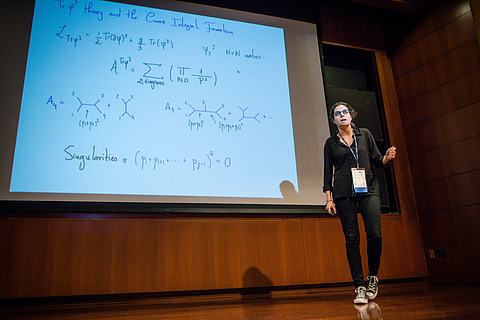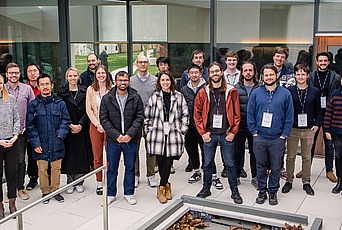
A Homecoming for Amplitudes at IAS
From June 10–14, around 230 physicists and mathematicians gathered at the Institute for Advanced Study to discuss a topic in physics known as scattering amplitudes. Scattering amplitudes compute probabilities for particle interactions, such as those at CERN’s Large Hadron Collider (LHC), famous for its discovery of the Higgs particle in 2012. The conference included an eclectic and expert group of speakers from numerous global institutions and labs, including Facebook AI and CERN. Following the event, a one-week summer school, aimed at graduate students and early-career researchers, was held from June 17–21.
Scattering amplitudes are vital for physicists studying our quantum mechanical universe. In a world where the results of high-energy particle collisions cannot be determined ahead of time, researchers in this field work on predicting the probabilities of the particles' various potential interactions with each other. This allows for more precise predictions to be made for the current models of physics that can be tested at colliders like the LHC.
However, emerging trends have further broadened the field's scope. Its application to gravitational-wave physics, for instance, relevant to computing the signals received by observatories such as LIGO, were discussed at Amplitudes 2024, in addition to the usual LHC-style physics, questions related to string theory, and the mathematical structures behind amplitudes.

“The Amplitudes conference is an event we look forward to every year because we get to hear about exciting results from different research groups,” said Hofie Hannesdottir, one of the organizers of the conference and a Member in the Institute's School of Natural Sciences. “This year, we had a truly outstanding group of speakers from all over the world. Learning from each other in this way really speeds up the progress in the field.”
Amplitudes 2024 was also organized by Nima Arkani-Hamed, Gopal Prasad Professor in the School of Natural Sciences and one of the leading particle physics phenomenologists of his generation, along with Penn State’s Jacob Bourjaily and IAS Member Sebastian Mizera.
“Despite working on problems in different areas, the attendees of the Amplitudes conferences share a common framework of thinking about physics,” said Mizera. “It’s really thrilling to be a part of such an active and diverse community.”
The roots of the Amplitudes conference, which started in 2009 and has since been held annually, can be traced back to seminal papers written in 2004–05 by Edward Witten, Professor Emeritus in the School of Natural Sciences, and his collaborators. These essential papers provided new methods which made the study of scattering amplitudes simpler and more efficient, culminating in the formulation of BCFW recursion relations by Witten and a group of IAS Members in the School of Natural Sciences at the time: Ruth Britto (2002–05, 2022–23), Freddy Cachazo (2002–05, 2009–10), and Bo Feng (2002–05). Since then, the field has continued to expand, and the conference, which has traveled the world, has now for the first time visited the campus from its origin story.

A few of the many exciting presentations given at this special homecoming Amplitudes conference were a talk on the combinatorial patterns in scattering amplitudes, the newest particle physics results from CERN, and the application of machine learning in physics.
Visit this video playlist for recordings of these lectures, and many more. A playlist of summer school lectures is also available.
The conference was sponsored by the Institute for Advanced Study, the Carl P. Feinberg Program in Cross-Disciplinary Innovation, the ERC Synergy Grant UNIVERSE+ (ERC, UNIVERSE PLUS, 101118787), and the Association of Members of the Institute for Advanced Study (AMIAS).


